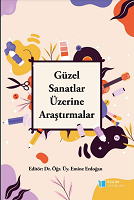Author(s): Eylem Tataroğlu / Language(s): Turkish
Publication Year: 0
In addition to developing skills specific to the age group for which it is provided, art education formation and content is one of the most effective and distinct ways to reflect the individual’s self-expression, and the chaotic spiritual state of especially children and young adults in adolescence by means of the alternatives it provides. Whether it be systematically provided, in ideal, or not, art and opportunities for expression have always existed since time immemorial, and they will keep existing forever. By nature, humans are not only consuming, but also wondering, producing, transforming, learning, sensing, and reasoning beings. For this reason, what seems to be simple yet is influential in this random order of functioning is the value they add to themselves, to their societies and to the world through their liveliness. This liveliness refers to mental, spiritual, and physical health and vivacity. This value is, most frequently, science, technology, or art. The fundamental function and goal of education, too, is to bring up mentally, spiritually, and physically balanced and healthy individuals. The most effectual tool in reaching this goal is art and design education. From pre-school to college, from the teen who receives art and design education at college to students enrolled in law, medicine, engineering, or classroom teaching programs, everyone has the right to live in an aesthetical environment and with well-balanced people, and the way to provide this in education is through art and design. People with self-confidence, taste, and the ability to express themselves represent the ideal citizen profile needed in all countries, and it is the duty of all democratic governments to train their citizens multi-dimensionally. In short, solving problems requires creativity, and skills through which to accurately evaluate and to analytically assess belong to independent individuals. The basic and easiest way to supply these is to train people, from a very young age, by means of art, to lay out the required educational environment under the leadership of teachers and academics who embrace art, and to assess the outputs of this systematic educational environment. The output of education is educated individuals. This is the fruit that demands the utmost care, that is achieved through the most arduous ways and in the longest time, and that is the most valuable for the society. Although creativity does not require education, its accurate appraisal and sustenance necessitates programed art and design education. Basic design/art education programs are those in which creative thinking develops and critical perspectives and peer reviews are prioritized. While the content and output of these programs help the students to form both personal and professional lives, they will also guide and lead them throughout life.
More...








